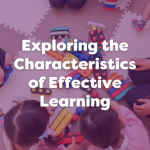Using technology as a tool for learning has never been more relevant to children’s lives. Rachel Hall, Managing Director of Busy Things, an online educational resource which provides fun learning games for children, told us about the positive effects that technology has in the classroom.
What are the benefits of using technology in the classroom?
There’s no doubt that technology is a big part of children’s lives now, and with so many useful teaching resources and apps online, there is certainly a place for it in the classroom. Don’t be panicked into the view that all technology is bad for children, because there are lots of positive ways that we can use it for education. I’ll be sharing just some of the many benefits of using technology as a tool for learning.

1. Boundary-free learning
The internet is easily the most useful tool we’ve got in the modern age. We’re waving goodbye to encyclopaedias and hello to the web, which provides great boundary-free learning for children. It encourages curiosity because kids know that they can find out an up-to-date answer to any question they have, without being restricted to the limitations of printed books.
You can even get access to YouTube videos, which can explain concepts and educate children in an engaging way. This is especially great for younger children, those with special needs or less developed readers, as they can still grasp the concept without having to read any tricky wording.
It’s very important that you always supervise what children are accessing on the internet by using filters and other child-safety precautions. Always watch YouTube videos and read content first before allowing children to see it.
2. Educational games make learning fun
The key to effective teaching is to make learning fun! Educational games are great at teaching children concepts in an entertaining and engaging way, through clever use of animation, sound and good game design.
The addition of scoreboards and the opportunity to play against friends are tried and tested ways to engage children, making them want to keep trying so that they can beat the highest score. High quality animation, character design and sounds are also great at captivating a child’s attention, especially when it comes to games that are about exploring a concept, such as composing music, drawing a picture or playing with shapes. Often, children can be so engrossed in the game they’re playing, that they don’t even realise they’re learning.
3. Learn coding
Since technology is becoming such a huge part of our lives, technology-based careers and interests are only growing, and have even been added to the school curriculum. Apps and games are a great way to teach these skills early in an engaging and child-friendly way. For example, by creating basic sequences and programmes, children can learn the principles of coding.
4. Promotes teamwork
Technology not only allows children to work independently, but it also offers the opportunity for group work. Some programmes can be hooked up to the interactive whiteboard, which means children can work in small groups or as a whole class, working together to solve problems and communicate ideas effectively.
5. Learning from home
Using apps and websites in teaching means that children can keep learning when they go home. As of 2017, the average amount of time children aged 0–8 spend on mobile devices has tripled since 2011, from five minutes to 48 minutes, according to research by Common Sense Media. Kids are now spending more time on computer devices than ever before, so why not encourage them to use this time to learn by sending home a recommended list of resources for parents to use?

Final thoughts
Using technology in the classroom is a great way to engage children in their learning. It’s an up-to-date way of teaching children all about the world around them, whilst encouraging team work and problem solving in a way that’s more relevant to the digital generation.



